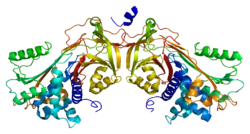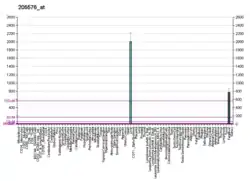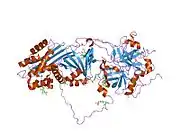Heparin cofactor II
Heparin cofactor II (HCII), a protein encoded by the SERPIND1 gene, is a coagulation factor that inhibits IIa, and is a cofactor for heparin and dermatan sulfate ("minor antithrombin").[5]
| SERPIND1 | |||||||||||||||||||||||||||||||||||||||||||||||||||
|---|---|---|---|---|---|---|---|---|---|---|---|---|---|---|---|---|---|---|---|---|---|---|---|---|---|---|---|---|---|---|---|---|---|---|---|---|---|---|---|---|---|---|---|---|---|---|---|---|---|---|---|
 | |||||||||||||||||||||||||||||||||||||||||||||||||||
| |||||||||||||||||||||||||||||||||||||||||||||||||||
| Identifiers | |||||||||||||||||||||||||||||||||||||||||||||||||||
| Aliases | SERPIND1, D22S673, HC2, HCF2, HCII, HLS2, LS2, THPH10, serpin family D member 1 | ||||||||||||||||||||||||||||||||||||||||||||||||||
| External IDs | OMIM: 142360 MGI: 96051 HomoloGene: 36018 GeneCards: SERPIND1 | ||||||||||||||||||||||||||||||||||||||||||||||||||
| |||||||||||||||||||||||||||||||||||||||||||||||||||
| |||||||||||||||||||||||||||||||||||||||||||||||||||
| |||||||||||||||||||||||||||||||||||||||||||||||||||
| |||||||||||||||||||||||||||||||||||||||||||||||||||
| |||||||||||||||||||||||||||||||||||||||||||||||||||
| Wikidata | |||||||||||||||||||||||||||||||||||||||||||||||||||
| |||||||||||||||||||||||||||||||||||||||||||||||||||
The product encoded by this gene is a serine protease inhibitor which rapidly inhibits thrombin in the presence of dermatan sulfate or heparin. The gene contains five exons and four introns. This protein shares homology with antithrombin III and other members of the alpha-1 antitrypsin superfamily. Mutations in this gene are associated with heparin cofactor II deficiency.[5] Heparin cofactor II deficiency can lead to increased thrombin generation and a hypercoagulable state.
A purification experiment of heparin cofactor II was performed in 1981, in which it was discovered that the purified version of the protein consists of a single polypeptide chain.[6] Further experimentation demonstrated that whether β-Mercaptoethanol is present does not affect HCII's activity in gel electrophoresis. β-Mercaptoethanol is typically used for the reduction of disulfide bonds within a molecule, but the gel electrophoresis revealed that HCII does not have any of these bonds. The structure is similar to antithrombin III (ATIII), which was known to effectively inhibit thrombin as well as coagulation factor Xa.[6] This experiment suggested that HCII has strong thrombin inhibition, yet weak inhibition of coagulation factor Xa.
Heparin cofactor II may play a role in the immune response, as it has been associated with leukocyte-mediated protein degradation, which releases cytokines in the inflammatory response with neutrophils and monocytes.[7] Its role has been questioned because although it is a thrombin inhibitor, an absence of HCII does not result in significantly higher levels of thrombosis.[7] This does not negate the results of the 1981 study, but novel discoveries create more questions of the biological mechanism and function of the protein. However, this cofactor shows stronger capability in inhibiting thrombin in pregnant women, protecting them from thrombosis. Pregnant women have shown increased levels of heparin cofactor II as well as dermatan sulfate, which is a polysaccharide that is expected to be involved in wound repair, coagulation, and overall maintenance throughout the body. Pregnant women who had thrombosis are likely to also have low levels of heparin cofactor II, but whether this is a causation is still unknown.[8]
References
- GRCh38: Ensembl release 89: ENSG00000099937 - Ensembl, May 2017
- GRCm38: Ensembl release 89: ENSMUSG00000022766 - Ensembl, May 2017
- "Human PubMed Reference:". National Center for Biotechnology Information, U.S. National Library of Medicine.
- "Mouse PubMed Reference:". National Center for Biotechnology Information, U.S. National Library of Medicine.
- "Entrez Gene: SERPIND1 serpin peptidase inhibitor, clade D (heparin cofactor), member 1".
- Tollefsen, D M; Majerus, D W; Blank, M K (March 1982). "Heparin cofactor II. Purification and properties of a heparin-dependent inhibitor of thrombin in human plasma". Journal of Biological Chemistry. 257 (5): 2162–2169. doi:10.1016/s0021-9258(18)34900-7. ISSN 0021-9258. PMID 6895893.
- Brummel-Ziedins, Kathleen; Mann, Kenneth G. (2018-01-01). "Molecular Basis of Blood Coagulation". Hematology: 1885–1905.e8. doi:10.1016/B978-0-323-35762-3.00126-8. ISBN 9780323357623.
- Huntington, James A. (2005-01-01). "Heparin Activation of Serpins". Chemistry and Biology of Heparin and Heparan Sulfate: 367–398. doi:10.1016/B978-008044859-6/50014-9. ISBN 9780080448596.
Further reading
- Griffith MJ, Carraway T, White GC, Dombrose FA (1983). "Serpin receptor 1: heparin cofactor activities in a family with hereditary antithrombin III deficiency: evidence for a second heparin cofactor in human plasma". Blood. 61 (1): 111–118. doi:10.1182/blood.V61.1.111.111.
- Pizzo SV (1989). "Serpin receptor 1: a hepatic receptor that mediates the clearance of antithrombin III-proteinase complexes". Am. J. Med. 87 (3B): 10S–14S. doi:10.1016/0002-9343(89)80524-8. PMID 2552799.
- Uszyński M (1992). "Tissue anticoagulants in the human placenta: preliminary study with a heparin-like anticoagulant and review of the literature". Gynecol. Obstet. Invest. 32 (3): 129–33. doi:10.1159/000293013. PMID 1836773.
- Sutherland JS, Bhakta V, Filion ML, Sheffield WP (2006). "The transferable tail: fusion of the N-terminal acidic extension of heparin cofactor II to alpha1-proteinase inhibitor M358R specifically increases the rate of thrombin inhibition". Biochemistry. 45 (38): 11444–52. doi:10.1021/bi0609624. PMID 16981704.
- Giri TK, Tollefsen DM (2006). "Placental dermatan sulfate: isolation, anticoagulant activity, and association with heparin cofactor II". Blood. 107 (7): 2753–8. doi:10.1182/blood-2005-09-3755. PMC 1895383. PMID 16339402.
- Liu T, Qian WJ, Gritsenko MA, et al. (2006). "Human plasma N-glycoproteome analysis by immunoaffinity subtraction, hydrazide chemistry, and mass spectrometry". J. Proteome Res. 4 (6): 2070–80. doi:10.1021/pr0502065. PMC 1850943. PMID 16335952.
- Rual JF, Venkatesan K, Hao T, et al. (2005). "Towards a proteome-scale map of the human protein-protein interaction network". Nature. 437 (7062): 1173–8. Bibcode:2005Natur.437.1173R. doi:10.1038/nature04209. PMID 16189514. S2CID 4427026.
- Schillinger M, Exner M, Sabeti S, et al. (2005). "High plasma heparin cofactor II activity protects from restenosis after femoropopliteal stenting". Thromb. Haemost. 92 (5): 1108–13. doi:10.1160/TH04-05-0311. PMID 15543340. S2CID 13806207.
- Collins JE, Wright CL, Edwards CA, et al. (2005). "A genome annotation-driven approach to cloning the human ORFeome". Genome Biol. 5 (10): R84. doi:10.1186/gb-2004-5-10-r84. PMC 545604. PMID 15461802.
- Suzuki Y, Yamashita R, Shirota M, et al. (2004). "Sequence comparison of human and mouse genes reveals a homologous block structure in the promoter regions". Genome Res. 14 (9): 1711–8. doi:10.1101/gr.2435604. PMC 515316. PMID 15342556.
- Corral J, Aznar J, Gonzalez-Conejero R, et al. (2006). "Homozygous deficiency of heparin cofactor II: relevance of P17 glutamate residue in serpins, relationship with conformational diseases, and role in thrombosis". Circulation. 110 (10): 1303–7. doi:10.1161/01.CIR.0000140763.51679.D9. PMID 15337701.
- Fortenberry YM, Whinna HC, Gentry HR, et al. (2004). "Molecular mapping of the thrombin-heparin cofactor II complex". J. Biol. Chem. 279 (41): 43237–44. doi:10.1074/jbc.M406716200. PMID 15292227.
- Zhang F, Wu Y, Ma Q, et al. (2004). "Studies on the effect of calcium in interactions between heparin and heparin cofactor II using surface plasmon resonance". Clin. Appl. Thromb. Hemost. 10 (3): 249–57. doi:10.1177/107602960401000307. PMID 15247982.
- Anderson NL, Polanski M, Pieper R, et al. (2004). "The human plasma proteome: a nonredundant list developed by combination of four separate sources". Mol. Cell. Proteomics. 3 (4): 311–26. doi:10.1074/mcp.M300127-MCP200. PMID 14718574.
- Strausberg RL, Feingold EA, Grouse LH, et al. (2003). "Generation and initial analysis of more than 15,000 full-length human and mouse cDNA sequences". Proc. Natl. Acad. Sci. U.S.A. 99 (26): 16899–903. Bibcode:2002PNAS...9916899M. doi:10.1073/pnas.242603899. PMC 139241. PMID 12477932.
- Noda A, Wada H, Kusiya F, et al. (2003). "Plasma levels of heparin cofactor II (HCII) and thrombin-HCII complex in patients with disseminated intravascular coagulation". Clin. Appl. Thromb. Hemost. 8 (3): 265–71. doi:10.1177/107602960200800311. PMID 12361205.
- Baglin TP, Carrell RW, Church FC, et al. (2002). "Crystal structures of native and thrombin-complexed heparin cofactor II reveal a multistep allosteric mechanism". Proc. Natl. Acad. Sci. U.S.A. 99 (17): 11079–84. Bibcode:2002PNAS...9911079B. doi:10.1073/pnas.162232399. PMC 123213. PMID 12169660.
- Cunningham MA, Bhakta V, Sheffield WP (2003). "Altering heparin cofactor II at VAL439 (P6) either impairs inhibition of thrombin or confers elastase resistance". Thromb. Haemost. 88 (1): 89–97. doi:10.1055/s-0037-1613159. PMID 12152684. S2CID 1467230.
- Hayakawa Y, Hirashima Y, Kurimoto M, et al. (2002). "Contribution of basic residues of the A helix of heparin cofactor II to heparin- or dermatan sulfate-mediated thrombin inhibition". FEBS Lett. 522 (1–3): 147–50. doi:10.1016/S0014-5793(02)02930-7. PMID 12095635. S2CID 12634527.
- Mitchell JW, Church FC (2002). "Aspartic acid residues 72 and 75 and tyrosine-sulfate 73 of heparin cofactor II promote intramolecular interactions during glycosaminoglycan binding and thrombin inhibition". J. Biol. Chem. 277 (22): 19823–30. doi:10.1074/jbc.M200630200. PMID 11856753.
- Böhme C, Nimtz M, Grabenhorst E, et al. (2002). "Tyrosine sulfation and N-glycosylation of human heparin cofactor II from plasma and recombinant Chinese hamster ovary cells and their effects on heparin binding". Eur. J. Biochem. 269 (3): 977–88. doi:10.1046/j.0014-2956.2001.02732.x. PMID 11846800.
External links
- The MEROPS online database for peptidases and their inhibitors: I04.019
- Heparin+Cofactor+II at the U.S. National Library of Medicine Medical Subject Headings (MeSH)
- He L, Vicente C, Westrick R, Eitzman D, Tollefsen D (2002). "Heparin cofactor II inhibits arterial thrombosis after endothelial injury". J Clin Invest. 109 (2): 213–9. doi:10.1172/JCI13432. PMC 150836. PMID 11805133.






